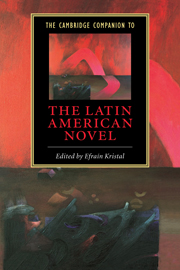17 - The Latin American novel in English translation
from Epilogue
Published online by Cambridge University Press: 28 May 2006
Summary
The earliest translations of the Latin American novel into English were sporadic and haphazard. One of the few nineteenth-century Latin American novels published in the first half of the twentieth century was Aves sin nido by the Peruvian Clorinda Matto de Turner, translated as Birds Without a Nest: a Story of Indian Life and Priestly Oppression in Peru (1904) by Thyne, a British Protestant press keen on underscoring the “priestly oppression” featured in the novel as the focal point of the defense of an oppressed indigenous people in need of salvation. The most unsavory elements of the novel were removed from the English version and duly restored by Naomi Lindstrom in her Texas University Press 1996 edition of that first translation.
Commercial publishers and small presses in the United States began to venture into the unknown wilds of South American writing in the 1920s and 1930s. New York based publishing houses such as Farrar and Rinehart (soon to be Farrar Straus, and by the 1960s, FS and Giroux) were seriously committed to the publication of some Latin American novels, and London editors such as Constable or Cape, and later on, others such as Faber and Faber tended to follow in the steps of their American counterparts by publishing English editions of the same translations within a year or two. An exception to this tendency occurred in the sixties and seventies when some of the more radical American published translations of experimental Latin American works were rejected, at first, because of the use of colloquial American speech and slang: two such examples were Manuel Puig’s Betrayed by Rita Hayworth (La traicioñ de Rita Hayworth, 1967) and Guillermo Cabrera Infante’s Three Trapped Tigers (Tres tristes tigres, 1965), both published in New York in 1971.
- Type
- Chapter
- Information
- The Cambridge Companion to the Latin American Novel , pp. 297 - 317Publisher: Cambridge University PressPrint publication year: 2005
- 2
- Cited by



